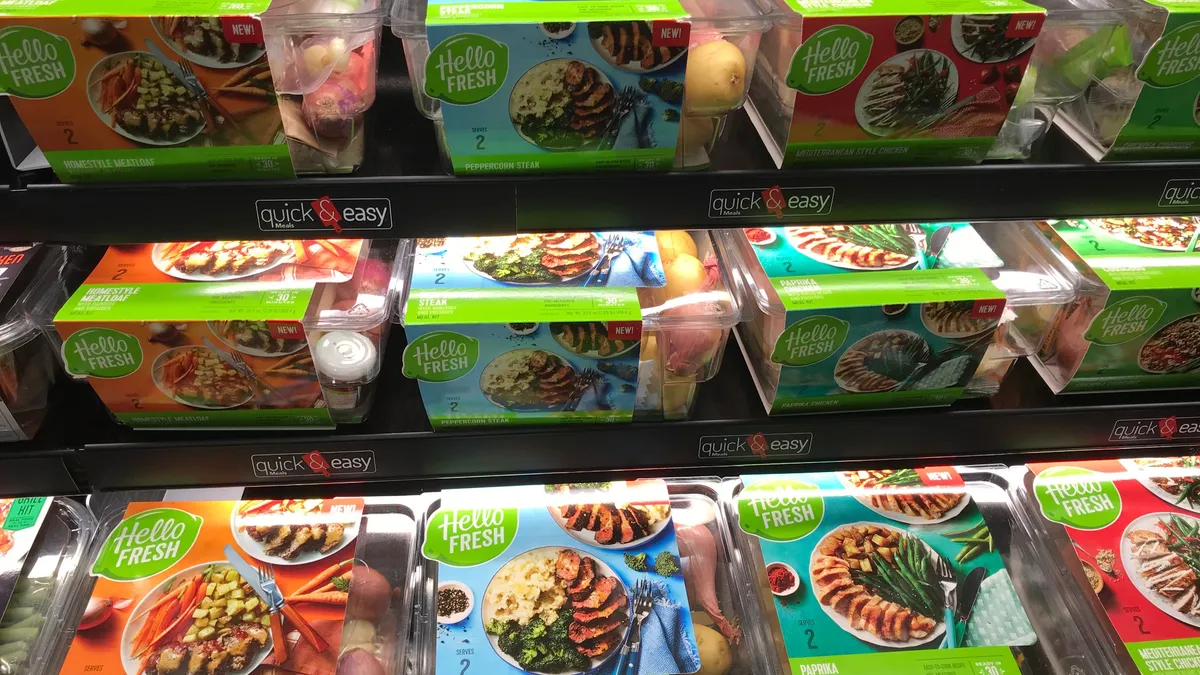Dive Brief:
- A new report from Packaged Facts forecasts the meal kit industry will continue to expand through 2023 but growth will slowly decline from double-digit gains to single-digit by 2023. The U.S. meal kit market had $2.6 billion in sales in 2017 and will grow about 22% by the end of this year to reach $3.1 billion.
- The firm expects that meal kit subscription services will mature quickly and other types of meal kits like in-store and non-subscription online orders will be preferred. As a result, Packaged Facts predicts leaders in the meal kit industry will adapt their business model to consumer preferences and meal kits will go from being a premium product to a convenience item.
- “The meal kit market is highly dynamic and prone to fluctuations, with the top meal kit providers falling in and out of favor since their introduction in the past few years,” David Sprinkle, research director for Packaged Facts said in a release. “Further complicating things, market expansion is expected to be much more reliant on alternative purchase venues than the traditional subscription delivery model due in part to the convenience and flexibility of online shopping.”
Dive Insight:
Since its start, the meal kit industry in the U.S. has faced difficulties attracting and retaining customers. But according to this latest report, as meal kit companies continue to evolve and meet consumer demands the market will stabilize.
With the steady rise of online grocery shopping, consumers have become more comfortable buying fresh products online, which has led to the expansion of the meal kit market. But companies like Blue Apron and HelloFresh have to deal with high costs and rising competition from supermarkets, restaurants and other channels. These outlets give customers the option to purchase fresh products only hours beforehand while meal kit dinners requiring a subscription must be planned out a week ahead of time. The traditional subscription model doesn't work for many consumers, and that has resulted in subscription cancellations or people never going past the free trial due to the feeling of being locked into the service.
As of now, meal kits are still seen as a service rather than a product. But as kit providers expand into new offerings and ordering models, they're trying to reach more and more consumers who might be turned off by the traditional model. Meal kit makers are also forging partnerships with retailers and delivery providers like GrubHub.
By having meal kits in stores and available for delivery, companies can accommodate demand for immediate consumption. Many grocers have also included the kits in their delivery and click and collect services, furthering that on-demand availability.
While this has been successful for many retailers and meal kit companies, it hasn’t provided positive results for all. In May, struggling Blue Apron hit the shelves of Costco hoping to reach more subscription-wary consumers. But this month, the retailer said it has temporarily removed all Blue Apron products from its shelves to make room for holiday products. This summer, Chef'd, which focused on in-store meal kits, ceased operations suddenly after it ran low on funds. The company was quickly snapped up by a California investment firm.
When it comes to online sales, which still make up the bulk of industry revenue, meal kit companies are beginning to offer non-subscription based products as well as quicker delivery, pre-made meals and meals that feature faster prep times. HelloFresh, for one, has rolled out meal kits that feature pre-chopped ingredients and can be prepared in less than a half hour.
While getting into retail stores seems to be a step in the right direction, meal kit companies still have a long way to go before they will no longer be seen as a premium, niche offering. Although convenient, in-store meal kits are still seen by many consumers as expensive, Packaged Facts notes. In order to appeal to more consumers, the firm stressed the importance of continuing to offer a wider selection of products, non-subscription options and creative new ways to get their products in front of consumers.













